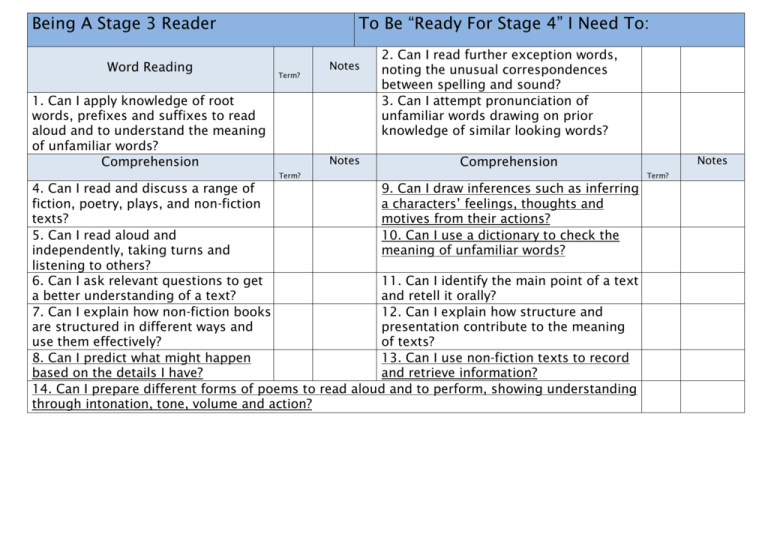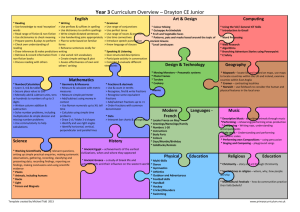Microsoft Word - New Year 3 Expectations
advertisement

Being A Stage 3 Reader Word Reading To Be “Ready For Stage 4” I Need To: Term? 1. Can I apply knowledge of root words, prefixes and suffixes to read aloud and to understand the meaning of unfamiliar words? Comprehension Notes Notes 2. Can I read further exception words, noting the unusual correspondences between spelling and sound? 3. Can I attempt pronunciation of unfamiliar words drawing on prior knowledge of similar looking words? Comprehension Term? 4. Can I read and discuss a range of 9. Can I draw inferences such as inferring fiction, poetry, plays, and non-fiction a characters’ feelings, thoughts and texts? motives from their actions? 5. Can I read aloud and 10. Can I use a dictionary to check the independently, taking turns and meaning of unfamiliar words? listening to others? 6. Can I ask relevant questions to get 11. Can I identify the main point of a text a better understanding of a text? and retell it orally? 7. Can I explain how non-fiction books 12. Can I explain how structure and are structured in different ways and presentation contribute to the meaning use them effectively? of texts? 8. Can I predict what might happen 13. Can I use non-fiction texts to record based on the details I have? and retrieve information? 14. Can I prepare different forms of poems to read aloud and to perform, showing understanding through intonation, tone, volume and action? Notes Term? Being A Stage 3 Writer To Be “Ready For Stage 4” I Need To: Transcription Notes Spelling Spelling Notes Term? Term? 1. Can I write from memory simple sentences dictated by the teacher? 2. Can I use the first two or three letters of a word to check a spelling in a dictionary? 3. Can I spell the commonly mis-spelt words from the Y3/4 list? (Progressive) 4. Can I identify the root in longer words? 5. Can I spell words with additional prefixes and suffixes and understand how to add them to root words? Composition Notes Composition Notes Term? Term? 6. Can I discuss models of writing, noting its structure, grammatical features and use of vocabulary? 10. Can I use a range of sentences with more than one clause by using a range of conjunctions? 7. Can I compose sentences using a wider range of structures? 8. Can I write a narrative with a clear structure, setting, characters and plot? 9. Can I write non-narrative using simple organisational devices such as headings and subheadings? 11. Can I proof-read to check for errors in: Spelling? Punctuation? Grammar? 12. Can I suggest improvements to my own writing and that of others? Grammar and Punctuation (SPAG seen in context) Notes Text Structure Sentence Structure Notes Term? Term? 13. Can I express time, place and cause by using conjunctions, adverbs and prepositions? 15. Can I start using paragraphs organised around a theme? 14. Can I begin to use fronted adverbials? 16. Can I use the present perfect form of verbs instead of the simple past? Punctuation Notes Term? 17. Can I use inverted commas to punctuate direct speech? Year 1 Year 2 Handwriting – (Separately Graded, Not Included in %) Year 3 Year 4 Year 5 Can I sit correctly at a table, holding a pencil comfortably and correctly? Can I form lower case letters in the correct direction, starting and finishing in the right place? Can I form capital letters and digits 0-9? Can I join my writing and show that I know which letters are best left unjoined? Can I form lower-case letters of the correct size relative to one another and use capital letters and digits of the correct size and relationship to one another and to lower case letters ? Can I use spacing between words that reflects the size of the letters? Can I use the diagonal and horizontal strokes that are needed to join letters? Do I understand which letters should be left unjoined? Can I use the diagonal and horizontal strokes that are needed to join letters? Do I understand which letters should be left unjoined? Is my handwriting legible and consistent; down strokes of letters are parallel and equidistant; lines of writing are spaced sufficiently so that ascenders and descenders of letters do not touch? Can I write legibly and fluently, developing speed and an appropriate personal style? Year 6 Can I write legibly and fluently, developing speed and an appropriate personal style? Being A Stage 3 Mathematician To Be “Ready For Stage 4” I Need To: Number Notes Number Notes Term? Term? 1. Can I compare and order numbers to 1000 and read and write numbers to 1000 in numerals and words? 2. Can I find 10 or 100 more or less than a given number? 3. Can I recognise the value of each digit in a 3digit number? 4. Can I understand and count in tenths and find the fractional value of a given set? 5. Can I add, subtract, compare and order fractions with a common denominator? 6. Can I recognise and use fractions as numbers: unit fractions and non-unit fractions with small denominators? 7. Can I recognise and show, using diagrams, equivalent fractions with small denominators? 8. Can I count from 0 in multiples of 4, 8, 50 and 100? 9. Can I derive and recall multiplication facts for 3x, 4x and 8x tables? 10. Can I add and subtract mentally combinations of 1-digit, 2-digit and 3numbers? 11. Can I add and subtract numbers with up to 3-digits using formal written methods? 12. Can I multiply and divide numbers using mental and progressing to formal written methods. 13. Can I estimate the answer to a calculation and use the inverse operations to check answers? 14. Can I solve word and number problems using one and two-step problems? Measurement and Geometry Notes Measurement and Geometry Term? 15. Can I identify horizontal and vertical lines and pairs of perpendicular and parallel lines? 16. Can I identify right angles and compare other angles, stating whether they are greater or smaller than a right angle? 17. Can I measure the perimeter of simple 2D shapes? 18. Can I draw 2D shapes and make 3D shapes, describing and recognising them in different orientations? Notes Term? 19. Can I measure, compare, add and subtract using common metric measures? 20. Can I solve one and two step problems using information presented in scaled bar charts, pictograms and tables? 21. Can I identify the number of seconds in a minute and the number of days in each month, year and leap year? 22. Can I tell and write the time, using specific vocabulary, to the nearest minute from an analogue clock, including Roman Numerals, 12 and 24-hour clocks.




